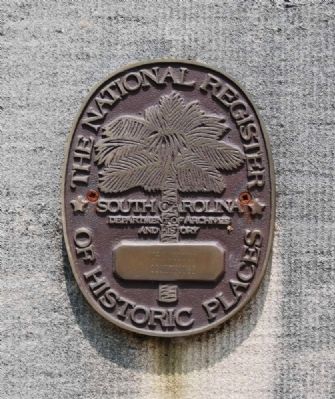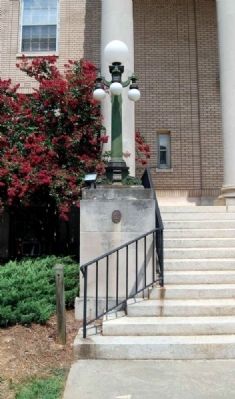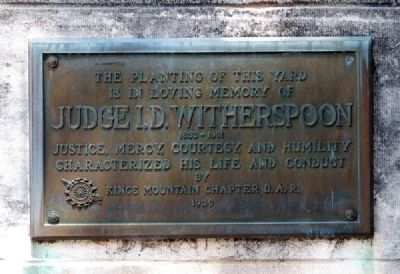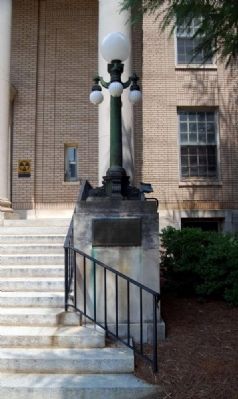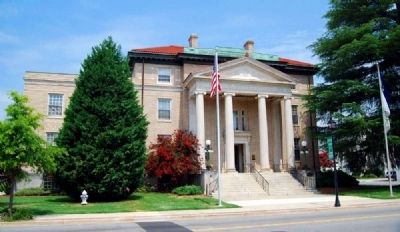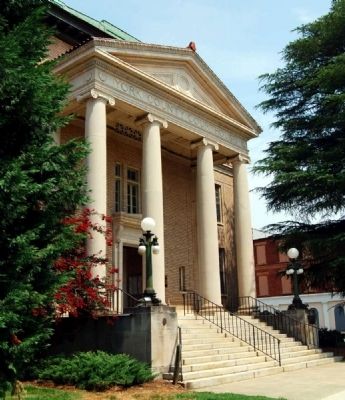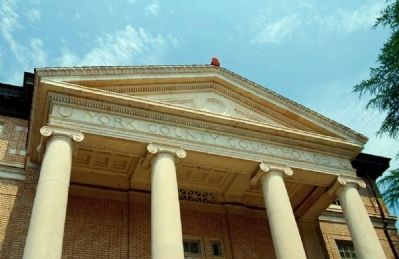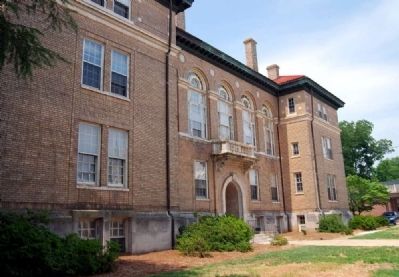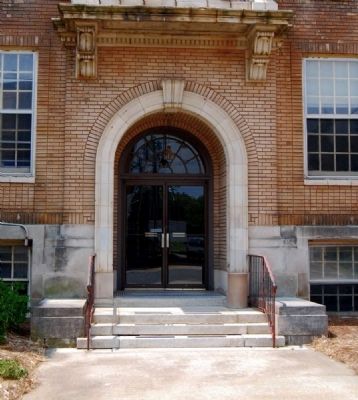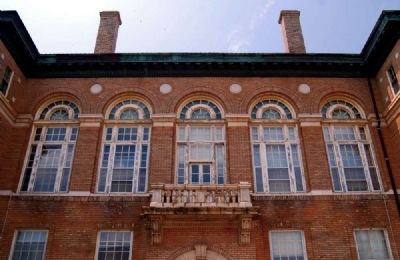York in York County, South Carolina — The American South (South Atlantic)
York County Courthouse
Inscription.
of Historic Places
York County
Courthouse
Erected 1981.
Topics and series. This historical marker is listed in this topic list: Notable Buildings. In addition, it is included in the Daughters of the American Revolution series list.
Location. 34° 59.633′ N, 81° 14.533′ W. Marker is in York, South Carolina, in York County. Marker is at the intersection of South Congress Street (State Highway 49) and West Liberty Street (State Highway 161), on the right when traveling south on South Congress Street. Touch for map. Marker is at or near this postal address: 2 South Congress Street, York SC 29745, United States of America. Touch for directions.
Other nearby markers. At least 10 other markers are within walking distance of this marker. York County Courthouses (a few steps from this marker); Historic York (within shouting distance of this marker); Bratton House Site / Jefferson Davis's Flight (within shouting distance of this marker); First Presbyterian Church (within shouting distance of this marker); Trinity M. E. Church, South (about 500 feet away, measured in a direct line); York County Veterans Memorial (about 600 feet away); Town of Yorkville / Town of York (about 700 feet away); Barnett Brothers Circus, 1929 ~ 1945 / Bennett Brothers Circus, 1929 ~ 1938 (approx. 0.2 miles away); Historic York, S.C. (approx. 0.2 miles away); York County Confederate Monument (approx. 0.4 miles away). Touch for a list and map of all markers in York.
Also see . . .
1. York County Courthouse. York County Courthouse is significant as a courthouse design of prominent architect William Augustus Edwards. (Submitted on July 6, 2011, by Brian Scott of Anderson, South Carolina.)
2. William Augustus Edwards. William Augustus Edwards, also known as William A. Edwards, (December 8, 1866 - March 30, 1939) was an Atlanta-based American architect renowned for the educational buildings, courthouses and other public and private buildings that he designed in Florida, Georgia and his native South Carolina. (Submitted on July 6, 2011, by Brian Scott of Anderson, South Carolina.)
Additional commentary.
1. York County Courthouse
York County Courthouse is a monumental two-story yellow brick building constructed in 1914. William A. Edwards was the architect.
The courthouse has the cross0axis
plan common to Edwards courthouses with the facade at the south end of the longitudinal axis. The facade features a colossal Ionic tetrastyle portico, projecting from a three-bay entrance pavilion on the five-bay elevation. The portico is of stone as are the entablature and the basement story. The columns of the portico are unfluted with Attic bases, Greek Ionic capitals, and a broad stone entablature. The entablature consists of an architrave with three fascia, a cyma reversa, and a fillet; a frieze, with paterae centered over the terminal columns, and the words "York County Courthouse" inscribed between these paterae; and a cornice, consisting of a cyma recta, a dentil course, a cyma reversa and cillet, a soffit and corna, and a crowning fillet. The cornice is raked into a pediment above the portico, where it is further enriched with an acanthus leaf cyma recta. The pediment features a central recessed medallion, with flanking triangular recesses, in its tympanum.
The facade behind the portico is three bays, of yellow brick, with a central entrance marked by a stone surround, which features console brackets supporting a stone cornice. A tripartite window is located over the entrance. The flanking bays have small one-over-one windows, on the first story only. Pilaster responds delineate the bays; the outer pilasters are of stone, and the inner pilasters are of brick.
The
single bays of the facade which flank the entrance pavilion have twelve-over-twelve windows on the first and second story. The portico entablature is carried around the building, in simplified form: the cornice is of stone, but without the dentils; the frieze is of brick; and the architrave is reduced to a corbelled yellow brick rowlock course. A broad attic story, of yellow brick, is located above the entablature; this attic story features six-over-six windows. A second cornice, of bronze, is located above the attic story. This cornice consists of a cyma recta, a dentil course, an ovolo, a course of console modillions, a soffit and corona, and a quirked cavetto. This second cornice is also carried around the entire building. A hip roof, sheathed in tile, is pierced by four yellow-brick chimneys.
The east elevation is five bays wide with single bay and pavilions. A central entry beneath a stone arch defines the transverse axis of the building. The second story has a five-bay arcade, encompassing the courtroom windows; the central window opens onto a stone cantilevered balcony. The end pavilions have paired nine-over-nine windows on the first and second stories. The entablature of the portico is carried through this elevation.
The opposite (west) elevation and the rear elevation, have two-story yellow brick additions, which continue the proportioning of the original building without the attention to detail.
The interior of the York County Courthouse features tile floors with inlaid Greek key patterning, marble wainscoting, and door surrounds, and stairs at both ends of the longitudinal hall. The courtroom on the second floor has a plaster vaulted ceiling; Tuscan pilasters lining the walls; and an apse at the north end, consisting of wooden crossetted tabernacle frame, which serves as a backdrop for the judge's seat. (Source: National Register Nomination Form.)
— Submitted July 6, 2011, by Brian Scott of Anderson, South Carolina.
2. Judge Isaac Donom Witherspoon
By Thomas F. Mcdow.
May it please your Honor: At the request of the members of the bar, I have been accorded the grateful privilege of asking your Honor to have entered upon the records of this Court these resolutions of respect and esteem for the cherished memory of the late Judge I.D. Witherspoon. It seems peculiarly proper that this testimonial of our regard for him should be offered in this forum, where he displayed the highest quality of an eloquent advocate and the stainless character of an upright judge.
Judge Witherspoon was born in this county on the 7th day of February, 1833, admitted to the bar in 1856, and at once entered upon a large and lucrative law practice. In April, 1861, he was happily married to Miss Margaret E. Wright, who, with two children, W.I. and Miss Leslie D. Witherspoon, survive him.
In August, 1861, he volunteered his services to the Confederacy and was lieutenant of Company A, Twelfth South Carolina Regiment. His health failing him, he was assigned to duty in the commissary department in Columbia, where he remained until the close of the war. On his return home he resumed the practice of his profession and associated himself with that splendid gentleman and accomplished lawyer, the late Colonel W. B. Wilson.
In 1876, when the State called on her sons for deliverance from the rule of the alien and the African, he led the fight in York county, and no one now living in this county will ever forget his wise counsel, nor how his eloquent tongue thrilled and stirred the men of York to redeem the State for white supremacy.
The office of State Senator sought him at a time when Carolina needed and called for the services of her strongest and purest sons, and his ability and character so impressed the Senate, then composed of the very flower of South Carolina manhood, that he was elected as its temporary presiding officer, and later . was elected to the high and honorable position of Judge of this, the Sixth Judicial Circuit, which office he held until 1898, when he voluntarily retired to private life.
Called by the voice of the people and by the representatives of the State to an exalted sphere of usefulness and honor as a State Senator and a Circuit Judge, he performed his part well and nobly, and fearlessly did his whole duty. His high power as an advocate was derived in a large measure from the earnestness of his convictions and the moral strength and purity of his character. He was an absolutely honest man, honest with himself and honest with courts and juries, and scorned to accomplish his aims by other than high and honorable means. As a judge he was conscientious and painstaking to the highest degree, and his strongest characteristic, as exhibited in his public and private life, was singleness of purpose to know and do what was just and right. On the bench he was dignified, kind and courteous and ever considerate of the feelings of others, without respect to their position or rank in life.
An approachable, lovable man, but of such dignity as to repel and forbid familiarity.
But, may it please your Honor, as distinguished as were his services to the State at the bar, in the Senate, and on the bench, we, his friends and associates, will love most to cherish his memory as a man; to remember his thoughtful respect and kindness to those with whom he came in contact; his tender sympathy and broad charity to those in sorrow or need; his gentle ministrations to the sick and afflicted in the community, and his readiness always to aid in any worthy cause. He was a gentleman and a most humble and devout Christian, and passed to his last reward in the fear and favor of God, as we believe, and in the respect and honor of all men who knew him.
I know of no man who has lived a more useful, a more beautiful life, nor one better prepared, when he had crossed the bar, "to meet his Pilot face to face."
I say of our departed friend what was said of another distinguished judge: "He has gone; the places that knew him once shall know him no more forever! and in bidding him our last farewell, it can be truthfully said that we shall never again be called upon in this Court to add our tribute of respect to higher manhood, a purer nature, a more refined mind, a sweeter courtesy, or a more becoming modesty, for these in the highest degree adorned and graced the public and private career" of Judge Witherspoon.
And now, may it please your Honor, I move the following resolutions:
"1. That in the death of the late Judge I.D. Witherspoon the State has sustained the loss of one of its purest and noblest sons.
"2. That by his conduct at the bar and on the bench, by his learning, his impartiality, his firm convictions of right, steady adherence to duty, and his unfailing courtesy in his intercourse with his fellow-men, he has endeared himself to the members of this bar as one of the brightest and noblest ornaments of our profession.
"3. That we tender to the members of his stricken home the assurance of our sincere and heartfelt sympathy in this their supreme sorrow, and that the clerk of this Court be instructed to transmit a copy of these resolutions to the family of the deceased.
"4. That these resolutions be entered on the minutes of the Court and a blank page dedicated to his memory, and as a further mark of our respect that this Court do now adjourn."
May 1, 1901. (Source: South Carolina Bench and Bar, Volume 1 by Ulysses Robert Brooks (1908) 262-264.)
— Submitted July 6, 2011, by Brian Scott of Anderson, South Carolina.
3.
National Register of Historic Places:
York County Courthouse ** (added 1981 - - #81000700)
• Also known as See Also:York Historic District
Corner of W. Liberty and S. Congress Sts. , York
• Historic Significance: Event, Architecture/Engineering
• Architect, builder, or engineer: Edwards,William Augustus
• Architectural Style: No Style Listed
• Area of Significance: Politics/Government, Architecture
• Period of Significance: 1900-1924
• Owner: Local
• Historic Function: Government
• Historic Sub-function: Courthouse
• Current Function: Government
• Current Sub-function: Courthouse
— Submitted July 6, 2011.
Credits. This page was last revised on June 16, 2016. It was originally submitted on July 6, 2011, by Brian Scott of Anderson, South Carolina. This page has been viewed 946 times since then and 30 times this year. Photos: 1, 2, 3, 4, 5, 6, 7, 8, 9, 10. submitted on July 6, 2011, by Brian Scott of Anderson, South Carolina.
